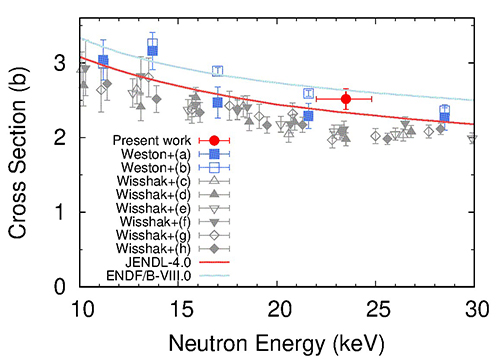Measurements of the neutron capture cross section of Am-243 at high energy region.
2022.06.14
Highlights
- The neutron capture cross section of Americium-243 (Am-243) around 23.5 keV has been measured in the neutron beamline ANNRI (Accurate Neutron-Nucleus Reaction Measurement Instrument) of the Japan Proton Accelerator Research Complex (J-PARC) by using a neutron filter.
- Present results contribute to developments of nuclear transmutation systems of High-Level Waste.
Summary
A The neutron capture cross section [term 1] of 243Am around 23.5 keV was measured by means of a neutron filter [term 2] installed at the ANNRI in the Materials and Life Science (MLF) in J-PARC. In the measurements, an Fe neutron filter provided a quasi-monoenergetic incident neutron beam around 23.5 keV and the neutron capture cross section of 243Am was measured by the time-of-flight (TOF) method [term 3]. The present result was determined with a much smaller uncertainty than the past data.
Background
Developments of the nuclear transmutation systems which reduce high-level nuclear waste (HLW) produced by nuclear power plants are ongoing. In the nuclear transmutation systems, long-lived radionuclides are converted into short-lived or stable nuclides through neutron-induced reactions. While the nuclear rection data of long-lived radionuclides are essential for the design of the nuclear transmutation systems, current status of the nuclear data does not satisfy the requirements for the systems. Therefore, the improvements of the neutron-induced reaction data is required.
In this works, the measurements of the neutron capture cross section of Americium-243 (243Am), which is one of the long-lived radioactive isotopes, was conducted. Although the nuclear data in the keV-energy region is required for the nuclear transmutation systems, the existing experimental data of 243Am is limited and there are discrepancies of these. Therefore, the current uncertainties of cross section data are far from the required accuracy. To improve the neutron capture cross section data of 243Am, experiments using the filtered neutron beam with the energy of 23.5 keV were carried out.Experiments
The measurements were carried out using a filtered-beam technique, by which a Fe filter (10 cm diameter, 20 cm thickness) was placed in a pulsed neutron beam from the spallation neutron source [term 4] at the MLF of J-PARC in Tokai-mura, Ibaraki. An americium sample was placed at a flight distance of 27.9 m in the ANNRI, a neutron beam line in J-PARC MLF, and the prompt gamma-rays emitted from the neutron capture reaction were detected with a NaI(Tl) detector. The neutron energy was determined by the time-of-flight method. The cross section was determined relative to the capture cross section of 197Au.
Results
The neutron capture cross sections of 243Am are shown in Fig. 1. The present result (red filled point) is larger than the past two data sets of Weston et al. and Wisshak et al. On the other hand, the evaluated data of ENDF/B-VIII.0 agree within the experimental uncertainty. Additional measurements at different keV-energy points using Si and Cr filters are planned.
This work was supported by MEXT Innovative Nuclear Research and Development Program. Grant Number: JPMXD0217942969.
Fig. 1 Neutron capture cross section of Am-243
Glossary
- [Term 1] Neutron capture cross section:
- A nuclear reaction in which a neutron is absorbed by a nucleus and becomes a part of the nucleus is called a neutron capture reaction. A probability for nuclear reactions is called cross section. Cross section of neutron-induced reactions depends on energy of the incident neutron.
- [Term 2] Neutron filter:
- In neutron-induced nuclear reactions, there is a phenomenon in which a reaction cross section at certain energies increases by many orders of magnitude, and this phenomenon is called resonance.
- [Term 3] Time-of-flight method:
- A method to measure the energy of neutrons. The neutron energy is determined by measuring the time of flight of a neutron over a certain distance.
- [Term 4] Spallation neutron source:
- When a particle of high energy in the order of GeV collides with an atomic nucleus, a spallation reaction occurs that breaks the nucleus into pieces. The spallation reaction produces a large number of neutrons, and is used as an efficient way to generate neutrons. Spallation neutron sources are being operated and constructed in many countries around the world to produce high-intensity neutron beams.
Journal information
- Journal :
- Journal of Nuclear Science and Technology
- Title :
- Measurements of the neutron capture cross section of 243Am around 23.5 keV
- Authors :
- Yu Kodama1), Tatsuya Katabuchi1), Gerard Rovira2), Atsushi Kimura2), Shoji Nakamura2), Shunsuke Endo2), Nobuyuki Iwamoto1), Osamu Iwamoto1), Jun-ichi Hoi3), Yuji Shibahara3), Kazushi Terada3), Hideto Nakano1), Yaoki Sato1)
- Affiliation :
- 1) Laboratory for Zero-Carbon Energy, Institute of Innovative Research, Tokyo Institute of Technology
2) Department of Nuclear Science and Engineering Directorate, Japan Atomic Energy Agency
3) Institute for Integrated Radiation and Nuclear Science, Kyoto University
